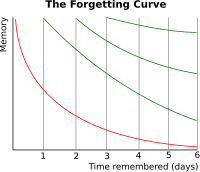Forgetting curve
The forgetting curve - also known as the Ebbinghaus curve - illustrates the degree of forgetting within a certain time. It was discovered by the German psychologist Hermann Ebbinghaus through experiments on himself and should u. a. show how long people keep what they have learned and what percentage they have forgotten. In connection with the forgetting curve, the Berlin professor also measured the number of repetitions as a function of the time required to be able to reproduce the memorized series of syllables without errors after a break . ( Savings method )
His results roughly say that just 20 minutes after learning, we can only access 60% of what we have learned. After an hour only 45% and after a day only 34% of what has been learned is in the memory. Six days after learning, on the other hand, memory has already shrunk to 23%; only 15% of what has been learned is stored permanently.
Forgetting depends on the type of material to be learned, for example people can usually better remember word pairs such as foreign-language vocabulary than random, meaningless syllables; After three to six days, pupils can still remember up to 90% of the vocabulary they have learned. Ebbinghaus, however, experimented with meaningless rows of syllables, which is why he u. a. Received criticism.
Reception and criticism
Experimental psychologists initially rated the construction of meaningless syllables as very positive, as they considered it to be a rigorous, methodical, scientific approach. Over time, however, Ebbinghaus came under criticism, above all, from holistic and shape-theoretical researchers. It was questioned whether the self-experiments with which Ebbinghaus set up the forgetting curve are suitable for delivering valid research results, since there was no control of disruptive factors in the sense of exercise effects. In other respects, too, it was criticized that the use of meaningless syllables in memory experiments led to a loss of control over disruptive factors. Senseless syllables, randomly formed by a vowel (or umlaut) and two consonants, can be meaningful or confused with dialect words, as the examples "Tür" or "nit" show. With regard to the methodology of the experiments u. a. inaccurate time measurement, the artificial learning situation and the reduction to repetitions of syllables to measure the memory method criticized.
The research and laws to which u. a. the curve of forgetting counts, Ebbinghaus earned the reputation of a pioneer in the field of memory research, which was still relatively unexplored at the time. In addition, numerous researchers, such as the Göttingen psychologist Georg Elias Müller , repeated Ebbinghaus's experiments with greater methodological rigor. The basic features of the findings are still considered to be valid today.
Heinz von Foerster has proven that each review of learning material for the retained learning material represents a new learning situation. In addition, this use of nonsense syllables for learning curves has only limited informative value for meaningfully learned relationships. Neurology and brain research have shown that personally meaningful learning is subject to completely different forgetting curves. Therefore, the following “Implications of the Forgetting Curve” are limited to nonsense syllables only.
Implications of the forgetting curve
- The process of forgetting must be lessened by repeating the learning material several times (over- learning ), with each repetition increasing the interval after which a new repetition is necessary. What you don't use in everyday life you forget; and only by constantly using the knowledge one keeps it.
- Learning materials must explain the meaning of the matter as clearly and concisely as possible and provide the learner with an overview at all times. For example, a student will first learn what hormones are and only then what effects each hormone has.
- The Ebbinghaus learning curve does not measure how many syllables could be reproduced correctly, but how much time it takes to learn it for the first time.
According to Christian Michel and Felix Novak (1990) the following forgetting curves apply approximately:
- "Principles and laws" are about 1% forgotten after 5 days and about 5% after 30 days
- Poems 25% or 50%
- Prose 53% or 60%
- meaningless syllables 78% or 80%
This clearly shows that it would be helpful when learning to explain the material in the form of principles and laws, perhaps also in the form of rhymes or stories.
See also
literature
- Hermann Ebbinghaus : About memory. Research on experimental psychology. Duncker & Humblot, Leipzig 1885.
Individual evidence
- ↑ Mark Galliker, Margot Klein, Sibylle Rykart: Milestones of Psychology. The history of psychology according to persons, work and effect (= Kröner's pocket edition . Volume 334). Kröner, Stuttgart 2007, ISBN 978-3-520-33401-5 , pp. 209-213.
- ↑ Helmut E. Lück: History of Psychology. Currents, schools, developments (= Outline of Psychology. Vol. 1 = Kohlhammer-Urban Pocket Books. Vol. 550). 3rd revised edition. Kohlhammer, Stuttgart 2002, ISBN 3-17-016987-4 , pp. 51-54.
- ^ (Apparently) Christian Michel, Felix Novak: Small psychological dictionary. (= Herder-Taschenbuch 1690). Extended and updated new edition. Herder, Freiburg (Breisgau) a. a. 1990, ISBN 3-451-08690-5 .
